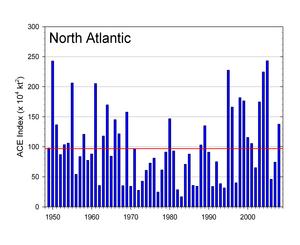Atlantic Basin
Averages:
The 2008 Atlantic basin hurricane season was above the 1950-2000 average with 16 named storms, of which eight were hurricanes, including five major hurricanes. The ACE index of hurricane activity indicated an above-average season, with a preliminary value of approximately 142 x104 knots2. In terms of accumulated cyclone energy (based on integrated wind power of all tropical cyclones during the season, both landfalling and those remaining out at sea), 2008 ranked as the 16th most energetic season out of the last 59.

Click for larger image Atlantic ACE
2008 Season Summary:
The first 2008 Atlantic storm to make landfall in the U.S. was Hurricane Dolly. The storm made landfall in South Padre Island, Texas on July 23rd. While there were no direct deaths from the hurricane, it caused an estimated $1.2 billion of damage. Tropical Storm Fay was the first storm in recorded history to make landfall four times in a single state. Fay first made landfall in southern Florida on August 18th and continued to batter Florida through the 21st. Thirty-six deaths were blamed on the tropical storm and damages are estimated in excees of $180 million.
On August 25th, Hurricane Gustav formed in the South Caribbean as the season's second major hurricane. Hurricane Bertha on July 3rd was the season's first. Hurricane Gustav first made landfall in Haiti and again in Western Cuba. On September 1st, Gustav made U.S. landfall in Louisiana as a category 2 hurricane. Gustav was blamed for 138 deaths in the U.S. and the Caribbean and an resulted in an estimated $4.3 billion of damage in the U.S.
As Gustav made landfall, Hurricane Ike began to form in the eastern Atlantic. Facilitated by favorable atmospheric conditions, Ike was able to quickly intensify into a category 4 hurricane on September 4th. On the 7th, while trying to recover from three earlier storms (Fay, Gustav, and Hanna), Cuba was hit again with winds estimated at 127-132 mph (203-213 km/h or 110-115 knots). Ike made U.S. landfall at Galveston, Texas, on September 13th as a category 2 hurricane. One-hundred-sixty-four deaths were blamed on Ike and damage estimates totaled more than $30 billion in the U.S., Cuba, and Bahamas, making Ike the 3rd costliest hurricane of all time behind Andrew and Katrina.
Hurricane Paloma was the last major hurricane in the Atlantic Basin's 2008 season. It was also the third major hurricane to hit Cuba (Gustav and Ike). This marks the first time on record that Cuba has been struck by three major hurricanes in one season. Paloma made landfall in Santa Cruz del Sur, Cuba on November 8th and caused an estimated $1.4 billion of damage.
This year was the second most destructive hurricane season on record with up to $54 billion in damage (2008 USD). The most destructive was $128 billion reported in 2005. It was the only year on record in which a major hurricane existed in every month from July through November in the North Atlantic (Bertha, Gustav, Ike, Omar, and Paloma). On July 20th, there were three active storms: Hurricane Bertha, and Tropical Storms Cristobal and Dolly. This was the earliest known date for three storms to be active on the same day. It is also noteworthy that none of the five major hurricanes (category 3 and above) were of major status at the time of U.S. landfall. This information is based on preliminary data and is subject to change. More details about all the 2008 Atlantic tropical systems can be found below.
Pacific Basin
|
Averages: The 2008 East Pacific basin hurricane season was near the 1950-2000 average with 18 named storms, of which seven were hurricanes, including two major hurricanes. The ACE index of hurricane activity indicated an below-average season, with a preliminary value of approximately 83 x104 knots2. In terms of accumulated cyclone energy (based on integrated wind power of all tropical cyclones during the season, both landfalling and those remaining out at sea), 2008 was below normal. |
 Click for larger image Pacific ACE |
|
2008 Season Summary: Eighteen named storms formed in the East Pacific Hurricane Basin during 2008, which is near the 50-year average. Seven of these storms were classified as hurricanes and two of these were major hurricanes (Category 3-5 on the Saffir-Simpson Scale). The most notable storm of the season was Norbert, which became a Category 4 hurricane on October 8. Norbert made landfall on the western side of the Baja Peninsula on the next day as a category 2. The storm then made another landfall in Mexico as a category 1, killing 8 people. Another notable storm in the East Pacific was Tropical Storm Alma. Alma made landfall on the northwestern coast of Nicaragua near León killing nine people. Damage from Alma is estimated at $33 million. | |
 NOAA's National Centers for Environmental Information
NOAA's National Centers for Environmental Information